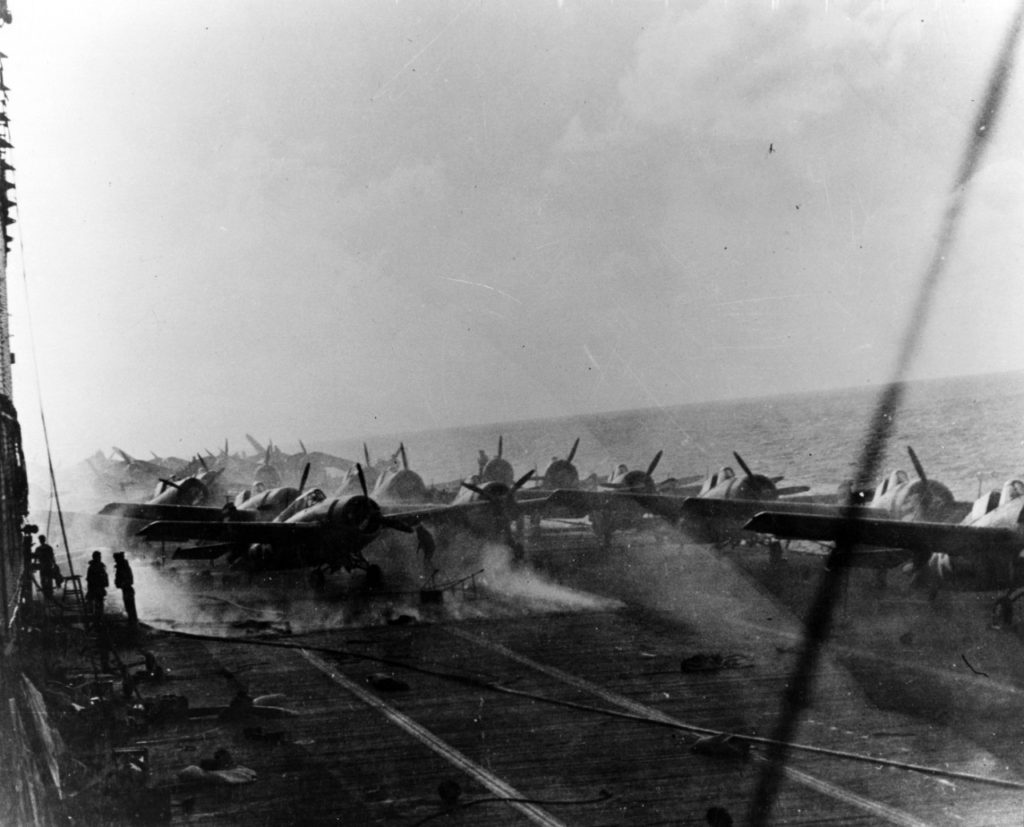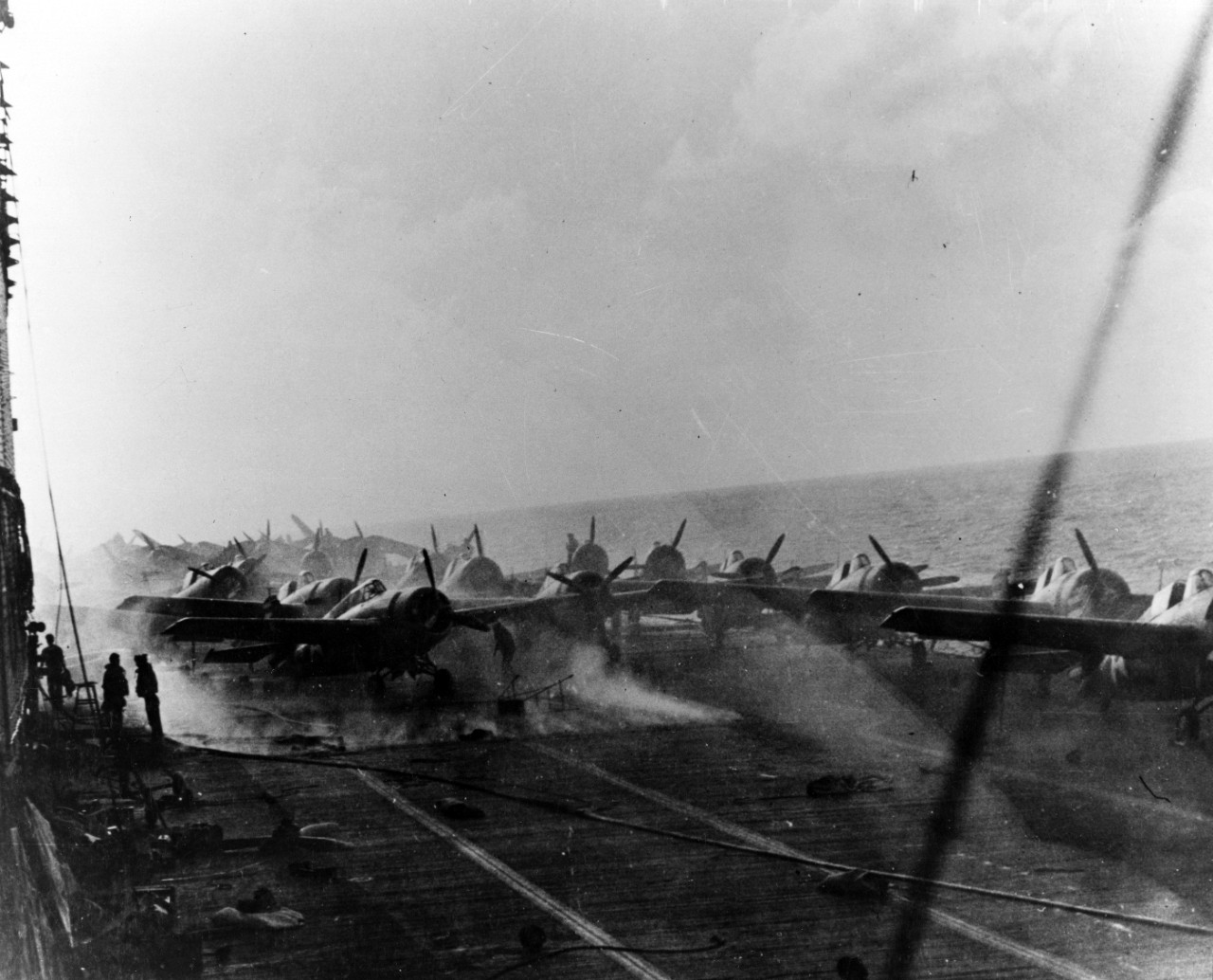War is hard, especially if you have to learn on the job. But that was the task American and Japanese naval officers faced in May 1942, as they fought the world’s first carrier versus carrier naval battle in the Coral Sea.
Usually described as a tactical victory for Japan but a strategic victory for the allies, the Battle of the Coral Sea can only be evaluated as one part of the year-long allied campaign to halt Japanese expansion – a campaign that included the American carrier raid on Rabaul in April 1942, the Battle of the Coral Sea in May 1942, the Battle of Midway in June 1942, and the invasion of Guadalcanal in August 1942.
That campaign – conducted primarily by American forces but including support from Australian surface ships, aircraft, and ground troops – stopped the Japanese advance, changed the character of the Pacific War, and, more importantly, sealed Japan’s fate.
Japan had but one chance to survive war against America and Britain. She somehow had to force America to give up the struggle while she herself was still intact. If the war was prolonged Japan stood no chance of overcoming America’s vast industrial capacity. In mid-1941, as Japanese naval leaders were putting the finishing touches on their plans to attack Pearl Harbor, the United States Navy and the Imperial Japanese Navy were nearly equal in strength. But while the Japanese had an additional three battleships, seven aircraft carriers, and five cruisers under construction, the U. S. Navy was building 17 battleships, 12 Essex-class aircraft carriers, 54 cruisers, 197 destroyers, 74 submarines and many hundreds of auxiliary ships, minesweepers, and small escort-type vessels.
America’s naval construction program was no secret. Japanese strategists knew that by 1944, when this building program was complete, Japan, its empire, and the whole East Asia Co-Prosperity Sphere would be annihilated, as long as America maintained the will to do so.
Admiral Yamamoto knew it. He famously said before Pearl Harbor that if Japan attacked America, it would win victories for six months to a year, but after that, he had no confidence.
Winston Churchill knew it. In his six-volume history of the war he wrote that upon hearing of the Pearl Harbor attack, his first thoughts were that victory over Germany and Japan was assured and that Japan “would be ground to a powder.”
So, Japan’s only hope was to break America’s will at the outset of the war. They hoped to do this by smashing the Pacific Fleet in a decisive battle, driving the survivors back to the West Coast, while constructing a vast interconnected network of island airbases (unsinkable carriers) that would make any U. S. counter-offensive so costly that America would lose heart and negotiate a peace that preserved the empire and Japan.
Thus, having secured their initial objectives in a series of lightning conquests in Malaysia and Indonesia, in early 1942 Japan attempted to create a major air base at Rabaul, cut American supply lines to Australia by seizing Port Moresby, lure the U.S. fleet into a decisive battle at Midway, and strengthen their defenses by building an airbase on Guadalcanal.
In the end, all four Japanese efforts failed. Rabaul was neutralized as an airbase by American carrier raids; the invasion of Port Moresby was turned back at Coral Sea; Midway was a decisive defeat for Japan; and the United States seized Guadalcanal’s valuable airstrip before the Japanese could finish it.
Here are a few significant facts about the Battle of the Coral Sea:
It was fought by pre-war forces.
Before Coral Sea, neither side had lost an aircraft carrier in the Pacific War, although Japanese carrier aircraft had sunk the HMS Hermes in the Indian Ocean in April 1942. The U.S. had lost the bulk of its pre-war battleship fleet at Pearl Harbor, but pre-war battleships were unsuitable as carrier escorts and did not participate at Coral Sea for either side. Japan employed three carriers at Coral Sea, while the United States deployed two, but the striking power of the fleets was almost identical as the three Japanese carriers had 127 planes while the two U.S. carriers had 128. The results of the battle reflected the pre-war training, professionalism, and preparation of Japanese and American pilots. Japanese pilots had an advantage in training and combat experience and they outperformed their American opponents.
It was the first carrier-carrier battle, and no one knew how to fight it.
At Coral Sea neither side understood the best tactical formation for protecting their carriers. Later in the war both sides understood that concentrating carriers and escorts to achieve massed defensive fire was the best course of action, but at Coral Sea neither side effectively massed its firepower.
During the two days of air strikes at Coral Sea, neither side was able to coordinate its attacks. U.S. bombers and torpedo planes did conduct simultaneous attacks against Shoho on the first day, but that coordination was unplanned and accidental. On the second day USS Yorktown dive bombers and torpedo bombers did conduct a coordinated attack against At Midway, one month later, the U.S. would again fail to coordinate its strikes.
Both sides suffered from inaccurate scouting reports and exaggerated and conflicting damage reports from pilots. Again, and again, scout planes inaccurately reported the location and disposition of enemy forces. This was a problem throughout the war, but at this early stage, naval leaders did not realize that the wildly inflated damage claims made by pilots were, in fact, erroneous. War is hard enough when the fragments of information available to commanders are accurate. It is nearly impossible when the only information commanders get is wrong. Throughout the battle Japanese and American commanders didn’t know who they were attacking, or how much damage their strikes had inflicted.
The air groups of both sides had too many strike planes and too few fighters to mount an effective defense. This would be corrected later in the war.
The outcome was unexpected
Pre-war doctrine had assumed that lightly built carriers could not survive a strike by aircraft. That belief was reinforced by the destruction of the heavily-armored and stoutly constructed warships HMS Repulse and HMS Prince of Wales off Malaysia in December 1942 and the destruction of the British aircraft carrier HMS Hermes in April 1942.
But three of the five carriers attacked at Coral Sea survived, and one – USS Yorktown – played a key role in the battle of Midway one month later. Carriers could be hit by dive bombers, but damage from above was unlikely to disable their engines or breach their hulls. Torpedoes were far more destructive to carriers, but torpedo attacks were more difficult to carry off. Carriers were most vulnerable when fueled and armed aircraft were caught on board, as the Japanese would learn to their sorrow at Midway.
The battle was badly managed by both sides
Naval commanders from both nations had a lot to learn about managing the carrier air war.
Compared to surface combat, air war required fast – almost instantaneous – decision-making, while the battle space had expanded enormously. Japanese commanders compounded their own problems by directing their forces from ashore at Rabaul, while the American forces were commanded by ADM Fletcher aboard USS Yorktown.
Neither side managed to strike their primary target on the first day. Both launched strikes against secondary targets due to target misidentification.
Although the U.S. carriers were equipped with radar, their crews were inexperienced and had difficulty vectoring defending fighters to the correct altitude against Japanese strikes.
The United States allowed its only oiler to be destroyed, severely limiting their ability to operate for extended periods. With USS Neosho gone, U.S. ships could operate only as long as they had fuel, which would be a few days at most.
It influenced the battle of Midway, perhaps decisively
At Coral Sea Japan lost the use of three aircraft carriers that had already been assigned to the Midway operation force. The loss of these ships and their aircraft significantly reduced the Japanese advantage at Midway and likely contributed to the Japanese defeat.
The loss of carrier pilots at Coral Sea was far more damaging to Japan than the loss of flight decks.
Japanese pilot losses were heavy in the opening months of the war and Coral Sea and Midway cost Japanese naval aviation another 200 skilled and experienced pilots. Japan had started the war with more than 2,000 trained naval aviators, so the loss of 200 pilots need not have been disastrous. But Japan never developed a system for training replacement pilots, so losses at Coral Sea, Midway, Eastern Solomons, and Santa Cruz crippled Japanese naval aviation for the remainder of the war.
Before the war Japanese carrier pilots averaged more than 800 hours of flying time, with some exceeding 2,000 hours. By early 1943, Japan was sending replacement pilots to the fleet who had fewer than 150 hours of experience. In the words of British military historian H. P. Wilmot, sending such inexperienced fliers into combat, “was tantamount to a death sentence.”
Code breaking greatly assisted U.S. forces
While codebreaking’s role in the U.S. victory at Midway is widely celebrated, codebreaking’s role at Coral Sea is less well-known. U.S. codebreakers had penetrated the Japanese naval code JN-25 in April 1942 and were able to read as much as 85 percent of signals. Of course, they could only read what the Japanese transmitted, and not all of that, so the information gained was fragmentary at best. But signals analysis, intuition developed through long experience, and fragments obtained by codebreaking – abetted by Japanese carelessness – convinced the Americans that the Japanese were planning an operation in the Southwest Pacific. Forewarned, the Americans were able to send carrier forces to the Coral Sea before the Japanese arrived.

View on the flight deck of USS Lexington (CV-2), at about 1500 hrs. on 8 May 1942, during the Battle of the Coral Sea. The ship’s air group is spotted aft, with Grumman F4F-3 fighters nearest the camera. SBD scout bombers and TBD-1 torpedo planes are parked further aft. Smoke is rising around the after aircraft elevator from fires burning in the hangar. Note fire hose, wheels, propellers, servicing stands and other gear scattered on the flight deck. Official U.S. Navy Photograph, now in the collections of the National Archives.
Catalog #: 80-G-16802
For a detailed discussion of the Battle of the Coral Sea, see: H. P. Willmott’s The Barrier and the Javelin: Japanese and Allied Pacific Strategies February to June 1942; Naval Institute Press, Annapolis, MD; 1983.
https://www.usni.org/press/books/barrier-and-javelin
May 9, 2019
